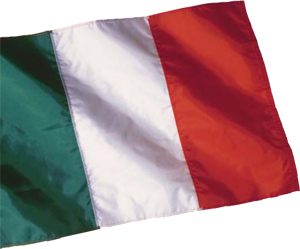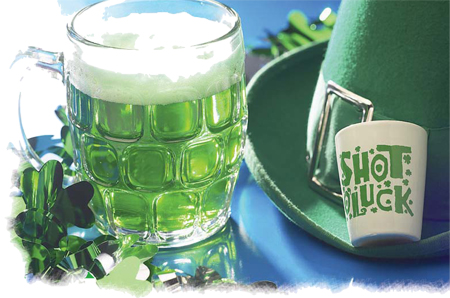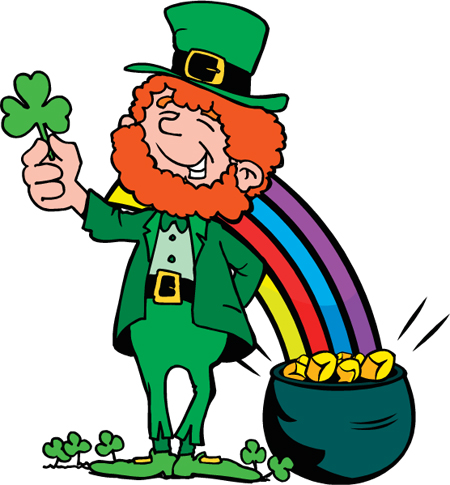
 Everyone is Irish on St. Patrick's Day. The Irish have
celebrated this day as a religious feast day for over 1500 years.
St. Patrick was responsible for converting the population of
Ireland from Paganism (many gods) to Catholicism. He died
on March 17th in 461 AD and that day has been
commemorated as St. Patrick's day ever since then. The fact
that this day falls in the middle of Lent probably helped
secure its popularity. The Lent prohibition against consuming
meat and drinking was waived for this day. The people would
attend Mass in the morning and then feast, dance, and drink
in the afternoon. They ate the traditional meal of Irish bacon
and cabbage. Irish bacon was later replaced by the less
expensive corned beef that the Irish in America were
introduced to by their Jewish neighbors. America truly is a
"melting pot" - or corned beef and cabbage pot.
Everyone is Irish on St. Patrick's Day. The Irish have
celebrated this day as a religious feast day for over 1500 years.
St. Patrick was responsible for converting the population of
Ireland from Paganism (many gods) to Catholicism. He died
on March 17th in 461 AD and that day has been
commemorated as St. Patrick's day ever since then. The fact
that this day falls in the middle of Lent probably helped
secure its popularity. The Lent prohibition against consuming
meat and drinking was waived for this day. The people would
attend Mass in the morning and then feast, dance, and drink
in the afternoon. They ate the traditional meal of Irish bacon
and cabbage. Irish bacon was later replaced by the less
expensive corned beef that the Irish in America were
introduced to by their Jewish neighbors. America truly is a
"melting pot" - or corned beef and cabbage pot.
The day was first
celebrated publically in
America - in Boston - in
1737. The first St.
Patrick's parade was
held in America, in
New York, on
March 17, 1762 by
Irish soldiers that
were serving in
the English
military. This
was before the American
revolution. As more and more Irish
immigrants came to the "new land" - Irish patriotism
grew. Initially, the majority of these ex-patriots were members
of the Protestant middle class. When the potato famine
devastated Ireland in 1845, almost a million poor,
uneducated Irish Catholics came to America to escape
starvation. They arrived penniless and weak from hunger and
were scorned for their religious beliefs and their funny
accents. For these new immigrants, even the most menial job
was hard to find. The Irish were typically given the most 
In Ireland, the day remained a religious occasion. Until 1970 pubs were closed for its observance. But by 1995 the Irish Government realized the increasing popularity of St Patrick's celebrations around the world - provided them a showcase for their county. In Dublin, it has grown to a multiday event featuring parades, concerts, fireworks and is attended by almost a million people yearly.
Patrick was a Roman - born in Wales and captured by the Irish at the age of sixteen. His given name was Maewyn. While in captivity he converted from paganism to Christianity. After six years of slavery, he escaped to Gaul (France) where he studied at a monastery for twelve years. Patrick was the Christian name he adopted. He believed his calling was to return to Ireland and convert the pagans. This is what he did for thirty years, traveling throughout Ireland establishing churches, monasteries, and schools. As for driving the snakes from Ireland - no snakes were ever native to Ireland. Many believe this fable was a metaphor for the conversion of the pagans. Today, what was once a religious holiday has grown into a secular day of fun and celebration of the Irish spirit. So on March 17th - grab a pint of green beer and:
May the road rise up to meet you.
May the wind always be at your back.
May the sun shine warm upon your face,
and rains fall soft upon your fields.
And until we meet again,
May God hold you in the palm of His hand.
An Old Irish Blessing

 The shamrock was initially a
sacred plant to the ancient
Celts in Ireland. It
symbolized the rebirth of
Spring. Saint Patrick was said
to have used it to illustrate
"The Trinity of Christianity"
and the possibility of three
aspects - being as one, although this has never
been substantiated. By the 1600's, as the English
began to seize Irish land and prohibit the practice
of Catholicism or the use of the native Irish
language, the shamrock was worn and became a
symbol of Irish unity. It is associated with St.
Patrick's Day simply because it is Irish.
The shamrock was initially a
sacred plant to the ancient
Celts in Ireland. It
symbolized the rebirth of
Spring. Saint Patrick was said
to have used it to illustrate
"The Trinity of Christianity"
and the possibility of three
aspects - being as one, although this has never
been substantiated. By the 1600's, as the English
began to seize Irish land and prohibit the practice
of Catholicism or the use of the native Irish
language, the shamrock was worn and became a
symbol of Irish unity. It is associated with St.
Patrick's Day simply because it is Irish.

 TThe cheerful, jovial
leprechaun is an
American invention -
due mostly to Walt Disney.
They're connected to St.
Patrick's Day because
they are fun fellows.
The Celts, the ancient
inhabitants of Ireland believed in fairies who had
magical powers. The fairies could use these
powers for good or for evil. The "lobaircins"
which meant "smalled bodied fellow," were
cranky souls that were responsible for mending
the shoes of other fairies. They were known for
their trickery - which they used to protect their
legendary great wealth. We've all heard of the
leprechaun with a pot of gold at the end of a
rainbow. Who's to say it's not true, laddie?
TThe cheerful, jovial
leprechaun is an
American invention -
due mostly to Walt Disney.
They're connected to St.
Patrick's Day because
they are fun fellows.
The Celts, the ancient
inhabitants of Ireland believed in fairies who had
magical powers. The fairies could use these
powers for good or for evil. The "lobaircins"
which meant "smalled bodied fellow," were
cranky souls that were responsible for mending
the shoes of other fairies. They were known for
their trickery - which they used to protect their
legendary great wealth. We've all heard of the
leprechaun with a pot of gold at the end of a
rainbow. Who's to say it's not true, laddie?